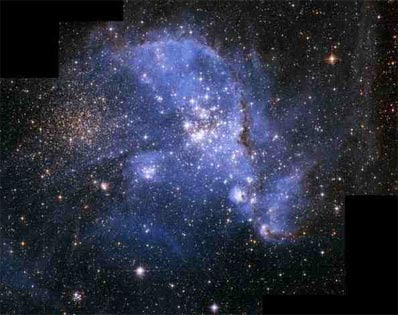 Spinning stars in the Small Magellenic Cloud with the wrong levels of mixing are challenging astronomers theories about massive stars.
Spinning stars in the Small Magellenic Cloud with the wrong levels of mixing are challenging astronomers theories about massive stars. Credit: A. Nota (ESA/STScI) et al., ESA, NASA.
Fast spinning, massive stars have shown that the way in which gases are mixed inside them isn't as simple as had been assumed, according to a new study involving the Very Large Telescope at the European Southern Observatory in Chile, and presented at the RAS National Astronomy Meeting at Queen's University in Belfast
Massive stars rotate very quickly, although nobody is sure why. Because massive stars only exist for a few dozen years before exploding as supernovae, compared to billions of years for lower mass stars like the Sun, astronomers do not know whether the fast rotation is down to their mass or whether it is down to their young age.
Regardless, the fast rotation creates powerful, spinning currents inside the massive stars that churns up the gases within them, a process termed 'mixing'.
However, the new study conducted by astronomers at Queen's University have found that this is not necessarily the case.
Spending 112 hours in total using the FLAMES multi-object spectrograph on the Very Large Telescope, which can measure spectra from 132 different objects simultaneously, they targeted 800 massive stars found in star clusters in the Large and Small Magellanic Clouds, and the Milky Way. To measure the amount of mixing, they studied the amount of churned up nitrogen that had made its way to the surfaces of these stars.
The clusters were divided up into ages of one to five million years, and 10 to 15 million years, to compare the different stages of their evolution. But they found that 20 percent of the stars were relatively slow rotators yet had an overabundance of nitrogen at their surfaces, whereas another 20 percent were fast rotators but had less nitrogen amongst their surface composition.
Additionally, they found that stars in the Small Magellanic Cloud span faster than their counterparts in the Milky Way that have a similar composition.
The remaining sixty percent appeared to fit previously established models, but the badly behaving forty percent suggest that other factors other than spin rate are at work in the mixing of material inside a massive star, which could affect how they evolve in terms of their lifetimes and specific type of supernova when they die.
Massive stars rotate very quickly, although nobody is sure why. Because massive stars only exist for a few dozen years before exploding as supernovae, compared to billions of years for lower mass stars like the Sun, astronomers do not know whether the fast rotation is down to their mass or whether it is down to their young age.
Regardless, the fast rotation creates powerful, spinning currents inside the massive stars that churns up the gases within them, a process termed 'mixing'.
However, the new study conducted by astronomers at Queen's University have found that this is not necessarily the case.
Spending 112 hours in total using the FLAMES multi-object spectrograph on the Very Large Telescope, which can measure spectra from 132 different objects simultaneously, they targeted 800 massive stars found in star clusters in the Large and Small Magellanic Clouds, and the Milky Way. To measure the amount of mixing, they studied the amount of churned up nitrogen that had made its way to the surfaces of these stars.
The clusters were divided up into ages of one to five million years, and 10 to 15 million years, to compare the different stages of their evolution. But they found that 20 percent of the stars were relatively slow rotators yet had an overabundance of nitrogen at their surfaces, whereas another 20 percent were fast rotators but had less nitrogen amongst their surface composition.
Additionally, they found that stars in the Small Magellanic Cloud span faster than their counterparts in the Milky Way that have a similar composition.
The remaining sixty percent appeared to fit previously established models, but the badly behaving forty percent suggest that other factors other than spin rate are at work in the mixing of material inside a massive star, which could affect how they evolve in terms of their lifetimes and specific type of supernova when they die.
BY KEITH COOPER
ASTRONOMY NOW
ASTRONOMY NOW